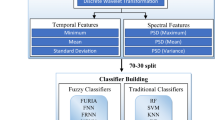Abstract
Analysis of EEG (Electroencephalography) for the detection of interictal activity amidst of artefacts for supporting the diagnosis of epilepsy is a time-consuming process that requires high expertise and experienced neurologist. The objective of the work is automated identification interictal activity in order to assist neurologists and also reduce the time consumed in visual inspection. For this work, four cases distinguishing interictal from a controlled activity are considered from the Bonn database. Non-linear properties from the complete signal such as correlation dimensions and properties such as approximate entropy, sample entropy and fuzzy approximate entropy from the specific sub-bands of frequency range A5 (0–2.7 Hz), D5 (2.71–5.4 Hz), D4 (5.4–10.8 Hz), D3 (10.85–21.7 Hz), and D2 (21.7–43.4 Hz) are used. Backpropagation neural network is used as a classifier. Performance parameters accuracy, sensitivity, and specificity are calculated. Ten-fold cross method is used as a validation method. For case 1, case 2, case 3, and case 4, the highest accuracy of 99.9%, 99%, 98.5%, and 99% has been achieved, respectively. The problem of interictal identification activity still remains unmapped to some extent this work focuses on the same and in this work we have achieved good performance measures in context to the same.
Access this chapter
Tax calculation will be finalised at checkout
Purchases are for personal use only
Similar content being viewed by others
References
Fisher RS, van Emde BW, Blume W et al (2005) Epileptic seizures and epilepsy: definitions proposed by the International League against Epilepsy (ILAE) and the International Bureau for Epilepsy (IBE). Epilepsia 46:470–472
Kobayashi T, Misaki K, Nakagawa H, Madokoro S, Ihara H, Tsuda K et al (1999) Non-linear analysis of the sleep EEG. Psychiatry Clin Neurosci 53(2):159–161. https://doi.org/10.1046/j.1440-1819.1999.00540
Lin R, Lee RG, Tseng CL, Zhou HK, Chao CF, Jiang JA (2006) A new approach for identifying sleep apnea syndrome using wavelet transform and neural networks. Biomed Eng Appl Basis Commun 18(3):138–144
Lin W-C, Chiu H-W, Hsu C-Y (2005) Discovering EEG signals response to musical signal stimuli by time-frequency analysis and independent component analysis. In: Proceedings of the 27th annual IEEE engineering in medicine and biology conference. Shanghai, China, pp 2765–2768
Babloyantz A, Nicolis C, Salazar JM (1985) Evidence of chaotic dynamics of brain activity during the sleep cycle. Phys Lett 111A:152–157
Acharya UR et al (2012) Automated diagnosis of epileptic EEG using entropies. Biomed Signal Process Control 7(4):401–408
Acharya UR, Fujita H, Sudarshan VK, Bhat S, Koh JEW (2015) Application of entropies for automated diagnosis of epilepsy using EEG signals: a review. Knowledge-Based Syst 88:85–96
Tawfik NS, Youssef SM, Kholief M (2016) A hybrid automated detection of epileptic seizures in EEG records. Comput Electr Eng 1(53):177–190
Acharya UR et al (2019) Characterization of focal EEG signals: a review. Future Gener Comput Syst 91:290–299
Andrzejak RG, Lehnertz K, Mormann F, Rieke C, David P, Elger CE (2001) Indications of nonlinear deterministic and finite-dimensional structures in time series of brain electrical activity: dependence on recording region and brain state. Phys Rev E 64(6):061907
Kumar Y, Anand MLDRS (2014) Epileptic seizures detection in EEG using DWT-based ApEn and artificial neural network, pp 1323–1334
Chen LL, Zhang J, Zou JZ, Zhao CJ, Wang GS (2014) A framework on wavelet-based nonlinear features and extreme learning machine for epileptic seizure detection. Biomed Signal Process Control 10(1):1–10
Xiang J, Li C, Li H, Cao R, Wang B, Han X, Chen J (2015) The detection of epileptic seizure signals based on fuzzy entropy. J Neurosci Methods 243:18–25
Song Y, Liò P (2010) A new approach for epileptic seizure detection: sample entropy based feature extraction and extreme learning machine. J Biomed Sci Eng 3(6):556–567
Bai D, Li X, Qiu T (2007) The sample entropy and its application in EEG based epilepsy detection. J Biomed Eng 24(1):200–205
Theiler J (1987) Efficient algorithm for estimating the correlation dimension from a set of discrete points. Phys Rev A 36(9):4456 American Physical Society
Sharma M, Pachori RB, Acharya UR (2017) A new approach to characterize epileptic seizures using analytic time-frequency flexible wavelet transform and fractal dimension. Pattern Recogn Lett 15(94):172–179
Hekim M (2016) The classification of EEG signals using discretization-based entropy and the adaptive neuro-fuzzy inference system. Turkish J Electr Eng Comput Sci 24(1):285–297
Wang Y, Li Z, Feng L, Bai H, Wang C (2018) Hardware design of multiclass SVM classification for epilepsy and epileptic seizure detection. IET Circ Dev Syst 12:108–115
Sriraam SRN (2017) Classification of epileptic seizures using wavelet packet log energy and norm entropies with recurrent Elman neural network classifier. Cogn Neurodyn 11(1):51–66
Jaiswal AK, Banka H (2017) Local pattern transformation based feature extraction techniques for classification of epileptic EEG signals. Biomed Signal Process Control 34:81–92. https://doi.org/10.1016/j.bspc.2017.01.005
Acknowledgements
The authors express appreciation to R. G. Andrzejaket et al. for their public accessible database [10].
Author information
Authors and Affiliations
Corresponding author
Editor information
Editors and Affiliations
Rights and permissions
Copyright information
© 2021 Springer Nature Singapore Pte Ltd.
About this paper
Cite this paper
Kaur, A., Verma, K., Bhondekar, A.P., Shashvat, K. (2021). Automated Identification of Interictal Activity from EEG Signal Using Non-linear Features. In: Gunjan, V.K., Zurada, J.M. (eds) Proceedings of International Conference on Recent Trends in Machine Learning, IoT, Smart Cities and Applications. Advances in Intelligent Systems and Computing, vol 1245. Springer, Singapore. https://doi.org/10.1007/978-981-15-7234-0_1
Download citation
DOI: https://doi.org/10.1007/978-981-15-7234-0_1
Published:
Publisher Name: Springer, Singapore
Print ISBN: 978-981-15-7233-3
Online ISBN: 978-981-15-7234-0
eBook Packages: Intelligent Technologies and RoboticsIntelligent Technologies and Robotics (R0)




